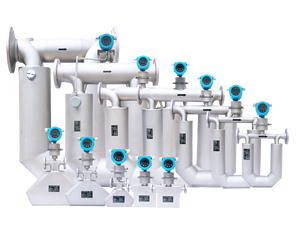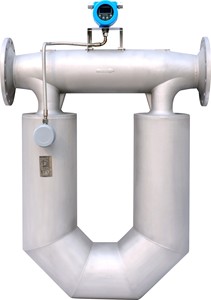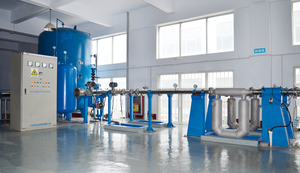
All categories
Featured selections
Trade Assurance
Buyer Central
Help Center
Get the app
Become a supplier

(324 products available)














































The fixed ultrasonic flow meter is the instrument in which the flow of fluids is measured. It does this based on the principle of the measurement of the difference in time between the detected ultrasonic signals through and against the flow by the fluid. There are several types, as explained below.
This type of flow meter measures the speed which the fluid is traveling through the pipe. It does this using two pairs of ultrasonic transducers positioned alternately on the pipe at 45-degree angles. Hence, the transducers send and recite an ultrasonic signal through the fluid. If the fluid is moving, the signal will take a shorter time doing to the flow direction than the opposite. The difference in time signals the fluid velocity. Then, a calculation differential converts fluid velocity to flow rate.
This works normally with the reflected ultrasonic waves from a target within the flow field that serves as the measuring liquid. Usually, this type of meter has a near and far transducer placed on the same pipeline. While the near transducer sends an ultrasonic pulse directed at the far transducer, the far transducer receives an echo of the pulse in case there's a reflection as a result of the flow. The time difference of the sent pulse and received echo will provide an ultrasonic measurement of flow.
Doppler works well where particles, bubbles, or gas are suspended in the flow. It utilizes an original ultrasonic signal that is scattered by suspended elements in the flow. When the flow is recast, the frequency of the scattered waves will change if the flow direction is against or with the fluid.
The change in frequency corresponds to flow velocity, while the shift of frequency will determine the flow direction. Also, the time of the reflected signal will change in accordance with the initial signal estimation, thus establishing flow rate.
As the name does not explain it, this flow meter combines the methods of transit-time and Doppler. It uses the time of flight estimation from both clear and scattered waves. The meter measures the flow rate and calculates the volume flow.
Fixed ultrasonic flow meter measures flow rates of water, both potable and non-potable, giving essential data for the purification and distribution processes. In wastewater, these fixed flow meters help measure the flow of waste that undergoes treatment before being released back into the environment.
In the oil and gas sector, these fixed flow meters are used to measure crude oil, gas, and petroleum-based products. The accuracy and ability to operate without contact make them great for hostile environments where hygiene and maintenance are issues.
The fixed flow meters are widely applied in the chemical industry where various chemicals, both liquid and gas, are transported and used. Since chemicals can be aggressive or corrosive, many of them have a structure that can resist this property.
In power plants, fixed meters are used to measure the flow of cooling water, steam, and various fuels, including gas and liquids. The precision of the flow measurements is important since it affects efficiency and safety.
Heating, Ventilation, and Air Conditioning (HVAC) systems use these meters to regulate and monitor the flow of water and refrigerants. This helps achieve energy efficiency as well as consistent temperature control.
The pharmaceutical industry needs strict adherence to hygiene and measurement precision when using flow meters. In this industry, fixed ultrasonic flow meters are applied when measuring various liquids and gases to manufacture drugs.
In the pulp and paper industry, these meters measure the flow of wood chips, pulp, and paper-making chemicals. Accurate flow measurement contributes to process optimization and product quality.
Mining operations, including the transport of slurries and various chemicals, utilize fixed ultrasonic flow meters. It helps in measuring the flow of process water and other important fluids used in ore processing in this industry.
Non-contact
Non-contact with the internal means that there will be no corrosion or wear and tear observed with time when compared to contact meters.
Bidirectional measurement
Bidirectional flow measurement is capable of measuring fluid flow in both forward and reverse directions.
High Accuracy
Usually, fixed types achieve an accuracy of around +0.5% to +2%. More accurate types are capable of measuring the flow more accurately than this.
Wide range of fluid
Reflecting upon the principle of working, fixed types can measure a wide range of fluids, including water, oil, chemicals, and slurries.
Robust design
The robust design of a fixed flow meter means the meter can be used in different areas: manufacturing, mining, chemical processing, and outdoor.
Digital display and output
There is a digital display feature that enables users to track real-time flow rates with ease. Also, the generated data can be used for historical analysis.
Low maintenance
Low maintenance is experienced because of the non-intrusive nature of the flow meter. Fixed types are quite easy to install.
Site selection
Select a suitable location for the installation of the flow meter. Ensure there will be no interference by existing pipework or other equipment. Also, consider the accessibility for maintenance and monitoring.
Pipe preparation
Ensure that the pipe where the flow meter will be installed is clean and free of any obstructions. Take proper measurements to ensure the right flow meter configuration choice.
Mounting the transducers
Ultrasonic transducers are fixed on the outside of the pipe. The transducer mounting locations should be aligned to ensure good ultrasonic signal transmission. Use proper adhesive or mounting brackets depending on the installation environment.
Cable connections
Once all the transducers are in place, connect the ultrasonic flow meter and power supply as well as the data output systems. Follow the manufacturer's instructions so that there will be proper wiring and configuration.
Calibration
Calibrate the flow meter so that accurate flow measurements are given. This will involve setting flow meter parameters, for instance, pipe diameter, fluid density, and sound velocity. The calibration procedure varies from one manufacturer to another; hence, it should be followed specifically.
Testing
After the calibration is done, test the flow meter to ensure it operates normally. The tracking of flow rates and comparison of the received data with expected standards is an indication that the meter is functioning correctly.
Power on the device
The flow meter should be powered on first. Most fixed flow meters have a power button on the device or can be powered remotely.
Configuration
Usually, fixed meters require initial configuration before the flow measurement is taken. This involves such parameters as pipe diameter, fluid type, and installation position. This configuration is mostly done through fixed meter interfaces like a keypad or by remote computing. Some fixed flow meters use software to configure the device.
Start measuring
The flow meter must be set in measurement mode after the configuration is complete. The meter begins measuring flow at this stage, with real-time values appearing on the display. For meters operated from remote, flow readout can be tracked from remote locations.
Regular monitoring and maintenance
Regular monitoring and maintenance are required to ensure the flow meter works properly. Periodically, check and clean the transducer if need be, and verify the measurement's accuracy.
Regular cleaning of transducers
Since the ultrasonic transducers are mounted externally, they are likely to accumulate dust, debris, or other substances. Regularly cleaning the transducers helps avoid the signal's scattering and makes accurate flow measurements possible. Cleaning should be done using a soft cloth and non-abrasive cleaner to avoid damaging the transducer surfaces.
Regular software and firmware updates
Many modern fixed ultrasonic flow meters come with software-based configurations and calibrations. Hence, it's significant that users frequently check if there are any updates for the flow meter software or firmware. This is necessary for the meter to work optimally and accurately. Updates can generally be found on the manufacturer's official site with installation procedures described well.
Periodic calibration
Regular calibration is recommended to ensure an accurate flow measurement is conducted. The frequency of calibration differs based on factors like the meter model, fluid type, and how the flow varies. Follow the manufacturer's guidelines on calibration frequency. Calibration can be done in the field or at the manufacturer's facility.
Inspect cables and connections
Cables and connections play an important role in the functioning of the flow meter. Hence, ensure there are no wearings, fraying, or corrosion. Corroded cables contribute to poor data transmission or meter failure completely. Replace or repair damaged cables as soon as possible to avoid interruption in flow measurement.
Check for updates
As the software updates have been mentioned earlier on, it is also very important that users periodically check for manufacturer announcements regarding hardware modifications or updates. Affected components or flow meters might experience improved functionality or fixed issues due to newly introduced internal parts or updates. It ensures high performance and the meter's reliability.
Manufacturers standard
Manufacturers standard is one of the most significant factors that determine ultrasonic flow meter quality. Purchase flow meters from reputable manufacturers that have met the set standards.
Materials
It applies to both the internal and external components of the flow meter. The quality of materials used affects the meter's lifespan, accuracy, and resistance to environmental conditions.
Calibration and testing
To guarantee that the flow meter will work reliably and correctly, it should undergo calibration and testing by the manufacturer before it's sold to end users.
Transducer technology
Advanced transducer technologies provide better accuracy and sensitivity to flow changes. Ensure the chosen fixed flow meter employs high-quality transducer technologies suitable for the specific application.
Feedback from customers
Customer feedback is also another quality consideration factor. Go through opinions and experiences of other users. They provide valuable insight into the model's long-term performance, reliability, and accuracy.
Response to environmental conditions
How a flow meter responds to extreme temperatures, pressures, and other environmental conditions is a sign of its quality. This factor depends mostly on the materials used in manufacturing the meter and its design.
Electrical safety
Fixed ultrasonic flow meters operate electronically. Flow meter set-up should be done in such a way that electrical safety precautions are well observed. Avoid using damaged cables and ensure grounding of the device.
Proper handling during installation
Some fixed flow meters are installed at a considerable height or in hard-to-reach areas. Proper handling during installation or maintenance is mandatory to avoid falling from the installed height and injuries.
Hygiene and chemical exposure
Though fixed flow meters are non-intrusive, they can be installed on pipelines that transport hazardous chemicals or gases. Practice hygiene and all necessary precautions to avoid exposure to such substances. It is advised to use personal protection equipment (PPE) when working near such equipment. Fixed flow meters must be installed or maintained after ensuring the flow of such hazardous substances is completely shut off.
Pressure conditions
Pipelines can be under high-pressure conditions. When working on such pipelines, care must be taken to avoid accidents. Turn off the pressure completely before trying to touch the pipeline or working on any installed equipment.
Measurement accuracy and equipment integrity
Prioritize safety by selecting high-quality flow meters that provide accurate measurements. Inaccurate readings can cause processes to operate unsafely, leading to equipment damage or even explosions in high-risk environments. When the flow rates are either too low or too high, it may cause equipment strain, leading to system failure and fire outbreaks.
A1. There are several advantages of fixed ultrasonic flow meters. They include: Working externally and thus making them not contact the fluid they are measuring. Because of this, there will be no wear and tear. Also, if the fluid is corrosive or dangerous, it poses no risk with the presence of a flow meter. High accuracy and precision in flow measurement. Bidirectional flow measurement capability. Easy installation on pre-existing pipelines and portability of the device. Minimal maintenance requirements; no moving parts.
A2. Although the flow meter is designed to measure the flow of various types of fluids, users need to ensure that the flow meter they will purchase is compatible with the fluid they want to measure, especially those that are more delicate. Most manufacturers provide guidance on which fluids their flow meters are best suited for. They can also offer custom solutions if need be.
A3. The right flow meter depends on various factors, such as the fluid's features, flow conditions, and pipeline characteristics. The most significant factors are pipeline diameter and flow rate. Generally, flow meters are available in a wide range of diameters, so choosing one that fits the host pipe is important. Furthermore, the meter must work within the flow rate range. If the flow rate is too high, measurement will be inaccurate. Low flow rates lead to meter incomprehensibility.
A4. Because the flow meter works externally, no internal cleaning is needed. Regular inspection and cleaning of the flow meter transducers are required for optimal performance. Use a gentle cloth to clean the transducer area. Never use harsh chemicals or abrasive materials that may damage the transducer surface. After long use of the flow meter, check for physical damage like cracks and wear. Also, check electrical connections for corrosion or loose connections.
A5. Yes, a change in ambient conditions affects the ultrasonic flow meter working principle and mechanism internally and externally. Most manufacturers offer flow meters that will work under a specific temperature and pressure range. Exceeding these ranges will adversely affect the flow meter's accuracy and performance. When dealing with extreme temperature or pressure conditions, always go for flow meters that manufacturers have designed specifically for this environment.